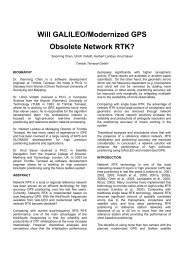GPS Integrity and Potential Impact on Aviation Safety - intelligent ...
GPS Integrity and Potential Impact on Aviation Safety - intelligent ...
GPS Integrity and Potential Impact on Aviation Safety - intelligent ...
Create successful ePaper yourself
Turn your PDF publications into a flip-book with our unique Google optimized e-Paper software.
NO. 1 <str<strong>on</strong>g>GPS</str<strong>on</strong>g> AND AVIATION SAFETY 55<br />
Table 2a. Performance failures related to err<strong>on</strong>eous clock behaviour.<br />
Performance failures Comments<br />
Satellite specific clock misbehaviour (based <strong>on</strong> type of<br />
atomic time st<str<strong>on</strong>g>and</str<strong>on</strong>g>ards used) often not detected. No notificati<strong>on</strong><br />
is given either within the navigati<strong>on</strong> message or<br />
through NANU.<br />
Satellite clock jumps leading to excessive pseudo-range<br />
deviati<strong>on</strong>.<br />
Malfuncti<strong>on</strong>s in the atomic frequency st<str<strong>on</strong>g>and</str<strong>on</strong>g>ards.<br />
Actual failure: In July 2001, a <str<strong>on</strong>g>GPS</str<strong>on</strong>g> satellite had a clock<br />
failure that caused range errors of thous<str<strong>on</strong>g>and</str<strong>on</strong>g>s of metres. The<br />
error lasted for approx 90 minutes (Clock failures are <strong>on</strong>e of<br />
the most comm<strong>on</strong> <str<strong>on</strong>g>GPS</str<strong>on</strong>g> failures).<br />
This can result in excessive code <str<strong>on</strong>g>and</str<strong>on</strong>g> carrier<br />
noise up to range errors of several thous<str<strong>on</strong>g>and</str<strong>on</strong>g><br />
metres.<br />
Drifting L1/L2 frequencies leading to wr<strong>on</strong>g<br />
range <str<strong>on</strong>g>and</str<strong>on</strong>g> Doppler measurements <str<strong>on</strong>g>and</str<strong>on</strong>g> loss of<br />
lock.<br />
Table 2b. Performance failures related to incorrect modelling <str<strong>on</strong>g>and</str<strong>on</strong>g> malfuncti<strong>on</strong> in the MCS.<br />
Performance failures Comments<br />
Incorrect modelling of orbital parameters during <str<strong>on</strong>g>and</str<strong>on</strong>g><br />
after a period of eclipse because of excessive temperature<br />
gradients leading to the need of more frequent navigati<strong>on</strong><br />
uploads. The Kalman clock state does not show a clear<br />
c<strong>on</strong>vergence.<br />
Incorrect modelling in the MCS Kalman filter due to<br />
shortcoming in the weighting mechanism.<br />
Actual failure: A failure occurred <strong>on</strong> 12–22 March 1993 due<br />
to err<strong>on</strong>eous modelling of the satellite orbits resulting in the<br />
broadcast of incorrect satellite co-ordinates. The failure<br />
caused ranging errors to increase steadily over the course of<br />
nearly two weeks. This did not show up in the performance<br />
m<strong>on</strong>itoring system at the time. The range errors were up to<br />
40 m.<br />
Actual failure: A failure occurred which was caused by<br />
incorrect modelling of the orbital parameters during <str<strong>on</strong>g>and</str<strong>on</strong>g><br />
after a period of eclipse. The effect was seen as a steadily<br />
increasing range error.<br />
Table 2c. Satellite payload related performance failures.<br />
This can result in wr<strong>on</strong>g satellite altitudes<br />
leading to wr<strong>on</strong>g range measurements due to<br />
wr<strong>on</strong>g ephemeris data.<br />
Performance failures Comments<br />
N<strong>on</strong>-st<str<strong>on</strong>g>and</str<strong>on</strong>g>ard code due to open time keeping system<br />
(TKS) loops (Block IIR). If this happens at the same time<br />
the telemetry is output by the navigati<strong>on</strong> data unit<br />
(NDU), a reset of the main processor may occur.<br />
Err<strong>on</strong>eous or corrupt navigati<strong>on</strong> data due to several<br />
reas<strong>on</strong>s (e.g. the i<strong>on</strong>isati<strong>on</strong> of silic<strong>on</strong> material used in<br />
memory devices by heavy i<strong>on</strong> cosmic rays <str<strong>on</strong>g>and</str<strong>on</strong>g> energy<br />
particles from the sun) leading to degraded navigati<strong>on</strong><br />
performance.<br />
This can lead to incorrect navigati<strong>on</strong> data or<br />
range errors.<br />
Satellites reset their processors every 24 sec<strong>on</strong>ds<br />
(BlockII/IIA) to m<strong>on</strong>itor qualityof navigati<strong>on</strong><br />
data (e.g. stored in memory). Block IIR<br />
satellites use a watchdog m<strong>on</strong>itor (WDM) to<br />
decide when a reset must occur.



